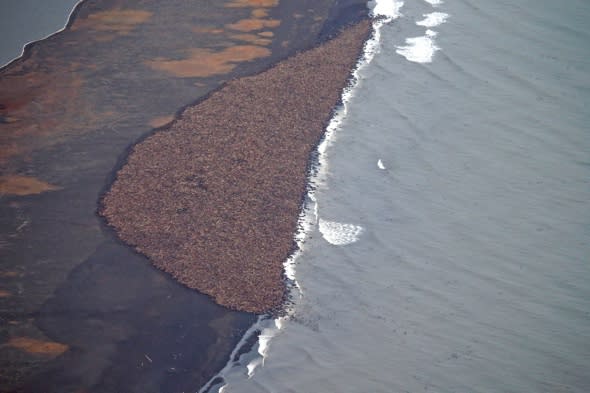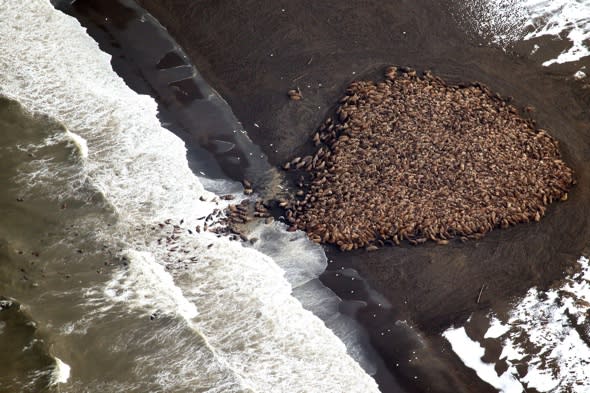Over 35,000 walrus flock to beach in Alaska after sea ice melts

Pacific walrus looking for places to rest in the absence of sea ice are coming to shore in record numbers on Alaska's northwest coast.
The National Oceanic and Atmospheric Administration (NOAA) confirms an estimated 35,000 walrus were photographed on Saturday about 700 miles northwest of Anchorage.
The aerial photo above was taken on 27 September 2014, and provided by NOAA, and some 35,000 walrus gathered on the shore near Point Lay, Alaska.
Point Lay is an Inupiat Eskimo village 300 miles southwest of Barrow and 700 miles northwest of Anchorage.
The enormous gathering was spotted during NOAA's annual arctic marine mammal aerial survey.

Pacific walrus spend winters in the Bering Sea, and females give birth on sea ice, using the ice as a diving platform to get snails, clams and worms on the shallow continental shelf, reports the Courier Mail.
As temperatures warm up in summer, the edge of the sea ice recedes north and the females and their young ride the edge of the sea ice into the Chukchi Sea, the body of water north of the Bering Strait.
In recent years, the sea ice has receded north beyond the shallow continental shelf waters and into Arctic Ocean water, where walrus cannot dive to the bottom as depths exceed two miles.
The walrus, particularly the young, can become vulnerable to stampeding when big groups gather so closely on the beach. Stampeding can be triggered by a polar bear, a human hunter, or a low-flying plane.
Indeed, observers last week saw about 50 carcasses on the beach from animals that may have been killed in a stampede.
According to the Daily Mail, The World Wildlife Fund said walrus have also been seen gathering in large groups on the Russian side of the Chukchi Sea.
Margaret Williams, managing director of the group's Arctic program, told the Mail Online: "It's another remarkable sign of the dramatic environmental conditions changing as the result of sea ice loss.
"The walruses are telling us what the polar bears have told us and what many indigenous people have told us in the high Arctic, and that is that the Arctic environment is changing extremely rapidly and it is time for the rest of the world to take notice and also to take action to address the root causes of climate change."
More amazing wildlife photos below:
Related articles
Walrus spotted on beach in Scotland 2000 miles from home
New atlas shows unseen world under polar ice





